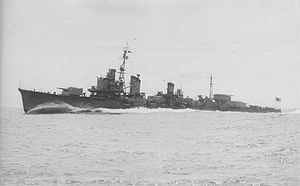Japanese destroyer Hayanami
 Hayanami underway on July 24, 1943
| |
| History | |
|---|---|
| Name | Hayanami |
| Builder | Maizuru Naval Arsenal |
| Laid down | 15 January 1942 |
| Launched | 19 December 1942 |
| Completed | 31 July 1943 |
| Stricken | 10 August 1944 |
| Fate | Torpedoed and sunk by USS Harder, 7 June 1944 |
| General characteristics | |
| Class and type | Yūgumo-class destroyer |
| Displacement | 2,520 long tons (2,560 t) |
| Length | 119.15 m (390 ft 11 in) |
| Beam | 10.8 m (35 ft 5 in) |
| Draught | 3.75 m (12 ft 4 in) |
| Speed | 35 knots (40 mph; 65 km/h) |
| Complement | 228 |
| Armament |
|
Hayanami (早波, "Early Waves") was a Yūgumo-class destroyer of the Imperial Japanese Navy.
Design and description[edit]
The Yūgumo class was a repeat of the preceding Kagerō class with minor improvements that increased their anti-aircraft capabilities. Their crew numbered 228 officers and enlisted men. The ships measured 119.17 meters (391 ft 0 in) overall, with a beam of 10.8 meters (35 ft 5 in) and a draft of 3.76 meters (12 ft 4 in).[1] They displaced 2,110 metric tons (2,080 long tons) at standard load and 2,560 metric tons (2,520 long tons) at deep load.[2] The ships had two Kampon geared steam turbines, each driving one propeller shaft, using steam provided by three Kampon water-tube boilers. The turbines were rated at a total of 52,000 shaft horsepower (39,000 kW) for a designed speed of 35 knots (65 km/h; 40 mph).[3]
The main armament of the Yūgumo class consisted of six Type 3 127-millimeter (5.0 in) guns in three twin-gun turrets, one superfiring pair aft and one turret forward of the superstructure.[2] The guns were able to elevate up to 75° to increase their ability against aircraft, but their slow rate of fire, slow traversing speed, and the lack of any sort of high-angle fire-control system meant that they were virtually useless as anti-aircraft guns.[4] They were built with four Type 96 25-millimeter (1.0 in) anti-aircraft guns in two twin-gun mounts, but more of these guns were added over the course of the war. The ships were also armed with eight 610-millimeter (24.0 in) torpedo tubes in a two quadruple traversing mounts; one reload was carried for each tube. Their anti-submarine weapons comprised two depth charge throwers for which 36 depth charges were carried.[2]
Construction and career[edit]
From 15–20 October 1943, Hayanami was used on troop transport runs from Saeki to Truk. The destroyer was used on troop transport runs from Truk to Ponape on 22-24 and 26–28 October. She provided escort for a troop transport run on 6 November to Bougainville.
On 7 June 1944, Hayanami was torpedoed and sunk by the submarine USS Harder near Tawitawi, 35 miles (56 km) east of Borneo (04°43′N 120°03′E / 4.717°N 120.050°E). The ship blew up and sank with 208 killed; 45 survivors were rescued by the destroyer Urakaze.
On 10 August 1944, Hayanami was removed from the Navy List.
Notes[edit]
References[edit]
- Campbell, John (1985). Naval Weapons of World War II. Annapolis, Maryland: Naval Institute Press. ISBN 0-87021-459-4.
- Chesneau, Roger, ed. (1980). Conway's All the World's Fighting Ships 1922–1946. Greenwich, UK: Conway Maritime Press. ISBN 0-85177-146-7.
- Jentschura, Hansgeorg; Jung, Dieter & Mickel, Peter (1977). Warships of the Imperial Japanese Navy, 1869–1945. Annapolis, Maryland: United States Naval Institute. ISBN 0-87021-893-X.
- Whitley, M. J. (1988). Destroyers of World War 2. Annapolis, Maryland: Naval Institute Press. ISBN 0-87021-326-1.
